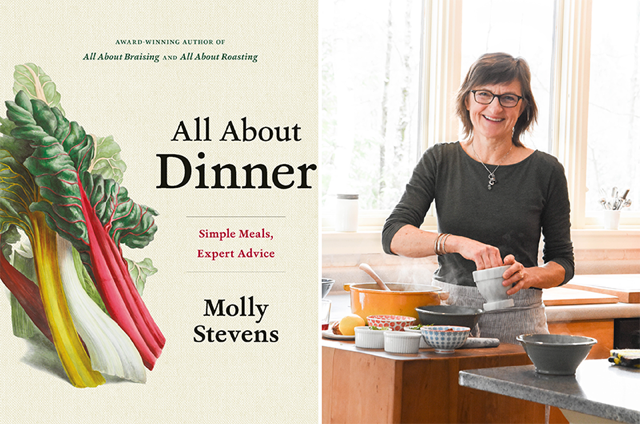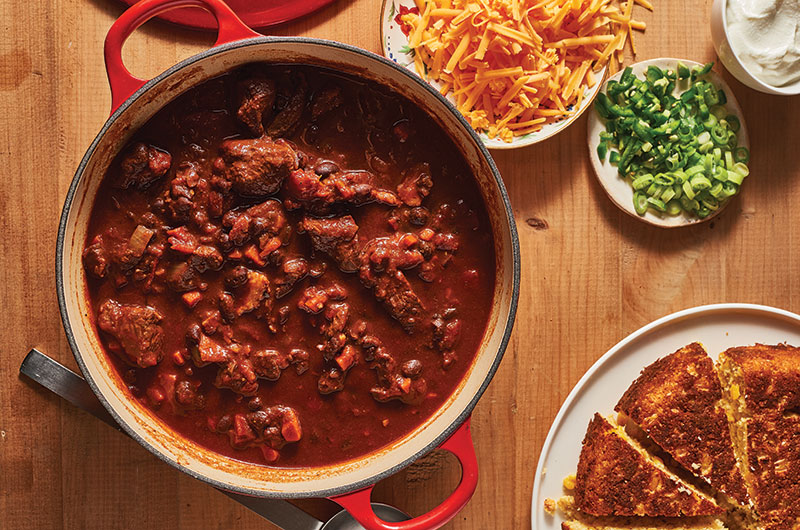In The Cook and The Book, an ongoing series brought to you by Martha's Vineyard magazine's Cook the Vineyard, we put the spotlight on cookbook authors we love by taking a look at their latest book.
THE COOK
Molly Stevens
Writer, cook, teacher — Molly Stevens is all three, and all three endeavors she approaches with her trademark gusto. That may be why Molly has been recognized again and again for her work in the culinary world. She has been named cooking teacher of the year by both Bon Appetit and the International Association of Culinary Professionals (IACP). Her two previous cookbooks, All About Braising and All About Roasting, each won both James Beard Society and IACP cookbook awards. Molly has been a long-time contributor to Fine Cooking magazine, and her recipes and articles have appeared in many national magazines.
Molly grew up in Buffalo, New York, in a large family that loved to gather around the table and that always welcomed guests, too. After college, Molly moved to France to pursue her dream of living a life dedicated to food and cooking. Back in the States, she worked at the French Culinary Institute in New York and then settled in Vermont, teaching for many years at the New England Culinary Institute. Molly also has a master’s degree from the Bread Loaf School of English. She lives outside of Burlington, Vermont.
Check out our chat with Molly below and read on for a preview of All About Dinner.
Follow Molly on Instagram @mstevenscooks
Visit Molly’s website
Follow Molly on Facebook
THE BOOK
All About Dinner: Simple Meals, Expert Advice
W.W. Norton, November, 2019
Hardcover $40
400 pp.
A Few Things We Love about All About Dinner
• This would be such a great book for a beginning cook. Molly has written the recipes as if she’s teaching a class (this was intentional) and each recipe includes explanations of techniques, doneness indicators (what to see, what to smell), ingredient substitutions, troubleshooting, and more.
• There’s an excellent section in the introduction called “15 Habits of Highly Effective Cooks.” Everyone can benefit from reviewing these, but again, new cooks will eat these up.
• In addition to the tips within the recipes, there are extensive sidebars throughout the book on everything from how to wash salad greens or how to zest citrus to how to make a skillet pasta, a risotto, or caramelized onions.
• So, all that’s to say: You can pick up and start reading any page in the book and have an aha! moment.
• The recipes themselves (see a list of our favorites below) are just what you want to make for dinner: comforting but fresh at the same time. Each one offers a repertoire-building opportunity — like the parchment-packet technique used in the recipe for Cod with Spinach, Tomatoes and Shallots. Suggested variations include Flounder with Buttery Leeks and Salmon with Tomatoes, Capers, and Olive Oil.
• We like the warm “feel” of the book, from the simple and pretty illustrated (hard) cover to the casual feel of the matte color photos, the easy-to-read type and the two-color sidebars. Along with Molly’s friendly tone, it’s a very accessible cookbook.
THE RECIPES
On Cook the Vineyard:
• Cheater’s Beef and Black Bean Chili
Other recipes in the book that we love:
• White Bean Gratin with Tomatoes and Sausage
• Roasted Halibut with Chile Lime Butter Sauce
• Cider Braised Pork Ragout
• Meatloaf Burgers with Bacon and Feta
• Butterflied Roast Chicken with Potatoes, Fennel, Rosemary and Orange
• Brussels Sprout Hash with Shallots and Mustard Seeds
• Whole Grain Waffles with Bacon and Parmesan
• Grilled Cubano
• Brown Butter Hazelnut Shortbread Cookies
• Popcorn Cornbread
THE ORGANIZATION
Chapters:
1 Salads
2 Soups and Stews
3 Pasta and Grains
4 Fish
5 Poultry and Meat
6 Vegetables
7 Snacks and Sandwiches
8 Sweets
9 Scratch Basics
THE SOURCES
Whenever possible, it's always a good idea to purchase your cookbooks through an independent bookstore, like our local Bunch of Grapes bookstore in Vineyard Haven. Independent bookstores can always order a book for you if they don’t currently have it. If you need to find out where your nearest independent bookstore is, check out IndieBound.org’s Bookstore Finder.
All About Dinner is also available online from:
The Q & A
Cook the Vineyard chats with Molly Stevens, November 2019
CTV: After two epic, award-winning technique books, what drove you to write All About Dinner? What was your mission and who were you aiming the book at?
Molly: First off, wow. I'm not sure I'd ever thought of my earlier books as "epic" – so thank you (I think) for that. But the sense that they are somehow serious and monumental may explain my impulse to write this book. I am certainly proud of both the braising and roasting books, but I wanted to write a more personal cookbook – one that better reflected who I am as a cook, an eater, and as a writer. Both my earlier books have large chunks of meat on the cover, and even though both books are loaded with recipes for vegetables, fish, and poultry, they are rather meat-centric, and the truth is, as much as I appreciate and enjoy good meat, I don't cook it or eat it every day. I wanted to write a book that reflected a more balanced way of eating, and that offered room for the grains, legumes, pulses, salads, soups, snacks, and even desserts that I cook and eat throughout the week. The recipes in this book are the types of dishes I cook for myself, my friends, and my family.
I also wanted to create a collection of recipes that a home cook could pick up for inspiration and instruction on an everyday basis. My hope is that this book will appeal to new cooks as well as those who already know their way around the kitchen.
CTV: How did your work as a cooking teacher influence the direction of the book?
Molly: I can't seem to write a recipe without bringing in all sort of "extra" information and instruction. It's what makes my recipes take up so much room on the page! I also love to write sidebars and boxes on techniques, ingredients, and tips. To me, that's the interesting part of a cookbook – both in the writing and reading. Recipes themselves are great, but where I get excited and inspired is all the extra learning that comes from being at the market and in the kitchen.
I also wanted to write a book that I could teach from for years to come – a book that would provide recipes and inspiration that I could teach to a number of audiences throughout the seasons.
CTV: We love the big sidebars in All About Dinner, especially when you provide a recipe, like a creamy soup, and then in the sidebar give us the general principals behind making a creamy soup so that we can riff on your recipe and make our own versions. What is your favorite feature in the book?
Molly: I'd have to say all the variations and ideas for riffing on any given recipe. Learning to cook is all about learning to cook without recipes. My hope is that cooks using this book will start by following my recipes carefully, and once they've made a dish successfully a few times (or as many times as it takes to feel confident and calm while cooking), they will then branch off and start cooking by feel instead of by rote. Once we are able to cook without looking at a printed page (or a screen), we can really pay attention to the way the ingredients and our techniques interact, and we can begin to make little changes to create new and exciting dishes on our own.
CTV: It must have been hard to decide which recipes to include. Did you have certain parameters or requirements for a recipe before it could be in here? Any favorite recipes?!
Molly: Oh my gosh, yes! It was a long and difficult process to narrow down the recipes. The basic parameters were pretty obvious: A recipe had to be fool-proof and delicious. I would send each recipe out to several testers (some professional, some untrained cooks), and I would often reassess the value of the recipe based on their combined feedback. In order for a recipe to be included, it had to have something that allowed it to stand out. Sometimes it was as simple as a twist on an old standard, like a coleslaw made with fennel and fresh ginger (and no mayonnaise), or maybe it was an opportunity to introduce readers to a favorite technique, like cooking fish in parchment paper, or pounding chicken breast into cutlets, or, the one you mentioned, the creamy vegetable soups. I'm always looking for ways that recipes can be more than a paint-by-numbers set of instructions. My goal is to write recipes that inform, inspire and educate.
Once I had all the recipes developed, tested and written up, there was also a lot of culling and reorganizing and I strived to create chapters that provided balance and variety. In the end, I believe there are at least 30 recipes that landed on the cutting room floor. That's always tough!
CTV: Your students often ask you what you cook at home—in fact that question was the impetus for this book. If you had to give home cooks a couple pieces of cooking advice, what would that be?
Molly: The best answer to this question is outlined in the section of the introduction entitled “15 Habits of Highly Effective Cooks" – but the simple answer is to cook and keep cooking. Find a few dishes that you love to eat (and share), and commit yourself to learning how to make them. My goal with this book is to encourage people to find a few recipes that appeal and then to head into the kitchen to prepare them. It's not about perfection or pyrotechnics, it's just standing in front of the stove and making something to eat.
Another bit of cooking advice is really shopping advice: the better your raw ingredients, the better your results. Learn to ask questions at the market (ideally a green market or farmers’ market), and develop a curiosity about unfamiliar ingredients. And finally, get in the habit of salting as you cook. As I like to say "salt early, and salt often."








